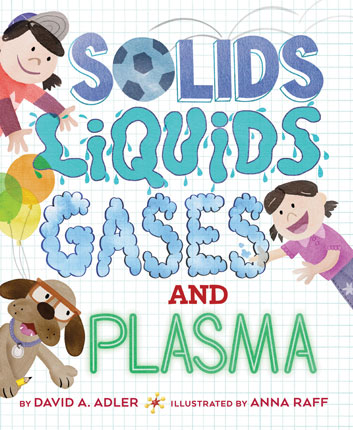| Solids, liquids, gases, and plasma Author: Adler, David A. | ||
| Price: $23.78 | ||
Summary:
Two children learn about four different states of matter (solid, liquid, gas, and plasma) and what happens when matter changes form.
| Illustrator: | Raff, Anna |
| Accelerated Reader Information: Interest Level: LG Reading Level: 4.20 Points: .5 Quiz: 508584 |
Reviews:
Kirkus Reviews (10/15/19)
School Library Journal (12/01/19)
Booklist (11/01/19)
The Bulletin of the Center for Children's Books (00/11/19)
Full Text Reviews:
Booklist - 11/01/2019 Adler and Raff, whose previous science books include Things That Float and Things That Don’t (2013), Magnets Push, Magnets Pull (2017), and Light Waves (2018), present the states of matter in their latest elementary science book. After discussing matter, molecules, and atoms, the text introduces solids, liquids, and gases, comparing the characteristics of those states as well as different substances within each state. Later, a double-page spread briefly describes plasma and offers examples, such as fluorescent and neon lights. In addition to illustrating the text, throughout the book, the digitally enhanced ink-wash illustrations show two children, their father, and their dog as they prepare for their grandmother’s birthday party and celebrate later that night. The party's never mentioned in the text, and this upbeat, visual narrative may distract some readers from the topic at hand. A few simple activities, such as one comparing the weight of a cup of water with another holding the same amount of oil, are described in the text and demonstrated by the characters in the pictures. Overall, a useful addition to the science shelves. - Copyright 2019 Booklist.
School Library Journal - 12/01/2019 Gr 2–4—Adler makes a commendable effort to introduce younger readers to a complex topic, with mixed results. He combines simply phrased explanations and demonstrations using measuring cups, balloons, and other common materials to make the differences between each classical state of matter easy to comprehend. The author goes a step beyond most similar overviews, notably Kathleen Weidner Zoehfeld's What Is the World Made Of?, by tackling plasma as well. However, he doesn't acknowledge the possibility of other states of matter (the University of Cambridge and the Oak Ridge National Laboratory discovered a new state of matter in 2016, as published in Nature Materials) and, more significantly, simplistically identifies smoke as a gas. Raff's bright cartoon illustrations add clarifying details and humor. Throughout the narrative, a frazzled dad messily undertakes the described demonstrations… helped by a dog who produces gas of its own. VERDICT A flawed but still engaging first look at the various states of matter, supported by hands-on components that are accessible to even the youngest experimental scientists.—John Peters, Children's Literature Consultant, New York - Copyright 2019 Publishers Weekly, Library Journal and/or School Library Journal used with permission.



